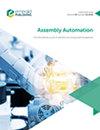Simulation and deep learning on point clouds for robot grasping
IF 1.7
4区 计算机科学
Q3 AUTOMATION & CONTROL SYSTEMS
引用次数: 7
Abstract
Purpose In this work, the authors aim to provide a set of convenient methods for generating training data, and then develop a deep learning method based on point clouds to estimate the pose of target for robot grasping. Design/methodology/approach This work presents a deep learning method PointSimGrasp on point clouds for robot grasping. In PointSimGrasp, a point cloud emulator is introduced to generate training data and a pose estimation algorithm, which, based on deep learning, is designed. After trained with the emulation data set, the pose estimation algorithm could estimate the pose of target. Findings In experiment part, an experimental platform is built, which contains a six-axis industrial robot, a binocular structured-light sensor and a base platform with adjustable inclination. A data set that contains three subsets is set up on the experimental platform. After trained with the emulation data set, the PointSimGrasp is tested on the experimental data set, and an average translation error of about 2–3 mm and an average rotation error of about 2–5 degrees are obtained. Originality/value The contributions are as follows: first, a deep learning method on point clouds is proposed to estimate 6D pose of target; second, a convenient training method for pose estimation algorithm is presented and a point cloud emulator is introduced to generate training data; finally, an experimental platform is built, and the PointSimGrasp is tested on the platform.机器人抓取点云仿真与深度学习
本文旨在提供一套方便的训练数据生成方法,然后开发一种基于点云的深度学习方法来估计机器人抓取目标的姿态。提出了一种基于点云的深度学习方法PointSimGrasp,用于机器人抓取。在PointSimGrasp中,引入点云模拟器生成训练数据,设计了基于深度学习的姿态估计算法。姿态估计算法经过仿真数据集的训练,可以估计出目标的姿态。在实验部分,搭建了一个实验平台,该平台由六轴工业机器人、双目结构光传感器和倾角可调基础平台组成。在实验平台上建立了包含三个子集的数据集。利用仿真数据集对PointSimGrasp进行训练后,在实验数据集上对其进行测试,得到的平均平移误差约为2-3 mm,平均旋转误差约为2-5度。主要贡献如下:首先,提出了一种基于点云的深度学习方法来估计目标的6D姿态;其次,提出了一种方便的姿态估计算法训练方法,并引入点云模拟器生成训练数据;最后搭建了实验平台,对PointSimGrasp进行了测试。
本文章由计算机程序翻译,如有差异,请以英文原文为准。
求助全文
约1分钟内获得全文
求助全文
来源期刊

Assembly Automation
工程技术-工程:制造
CiteScore
4.30
自引率
14.30%
发文量
51
审稿时长
3.3 months
期刊介绍:
Assembly Automation publishes peer reviewed research articles, technology reviews and specially commissioned case studies. Each issue includes high quality content covering all aspects of assembly technology and automation, and reflecting the most interesting and strategically important research and development activities from around the world. Because of this, readers can stay at the very forefront of industry developments.
All research articles undergo rigorous double-blind peer review, and the journal’s policy of not publishing work that has only been tested in simulation means that only the very best and most practical research articles are included. This ensures that the material that is published has real relevance and value for commercial manufacturing and research organizations.
 求助内容:
求助内容: 应助结果提醒方式:
应助结果提醒方式:


